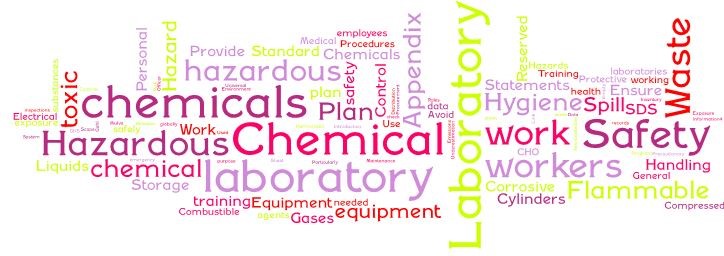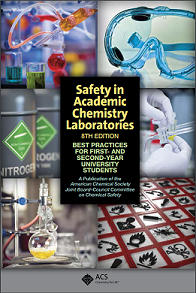
Chemical Hygiene at St. Norbert College
The chemical hygiene site seeks to provide easy online access to training, resources and plans. Here, you can find information to help prevent, recognize, identify and characterize hazards (a potential source of danger or harm) while ensuring compliance with federal, state and local regulations and policies.
Working in laboratories requires that you learn to apply the RAMP concept:
Recognize hazards
Assess the risk of hazards
Minimize the risk of hazards
Prepare for emergencies
To learn more about each statement, check out the ACS publication Safety in Academic Chemistry Laboratories (links provided below).
St. Norbert College follows the best practices provided in the ACS publication Safety in Academic Chemistry Laboratories.
Please click on the picture to read the 76 page booklet. If you need a refresher in a specific area, select on any of the chapter links listed below.
Table of Contents
Chapter 1 - Being Safe in the Laboratory ..............................10-13
Chapter 2 - Your Responsibility for Safety in Laboratories .....14-25
Chapter 3 - Guide to Chemical Hazards .................................26-45
Chapter 4 - Recommended Laboratory Techniques................46-57
Chapter 5 - Safety Equipment and Emergency Response.......58-69
Key information to remember:
Read the procedure ahead of time, listen carefully to your instructor's directions and always follow the basic safety information provided for each lab. Ask questions if you need assistance during the prelab discussion.
Always follow the laboratory procedures and processes which are designed to protect you as you gain hands-on experience and confidence in working in a laboratory setting.
Minimize hazards by keeping aisles free of book bags (tripping hazard), and wiping down your work area for the next user, and cleaning any spills on the balances as instructed to prevent chemical exposure hazards.
Properly disposing of any waste generated during your experiment protects laboratory workers and the environment. Your professor will advise you in the proper waste disposal method, (most often lab waste is placed in a specifically labeled container located in a fume hood). Ask for guidance if you are unsure.
Incident prevention is a collective responsibility, which requires the full cooperation of everyone in the laboratory.
By developing and practicing safe work habits in each laboratory session, we can achieve the goal of zero injuries or illnesses as a result of your laboratory experience.
Links to other topics:
Contact Info
Mark Musser, Chemical Hygiene Officer (CHO)920-403-4019
mark.musser@snc.edu














